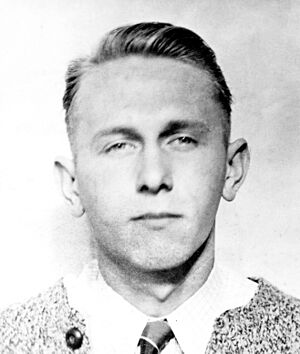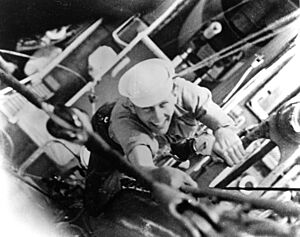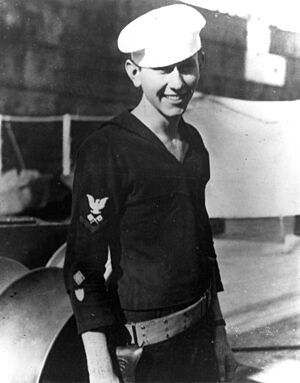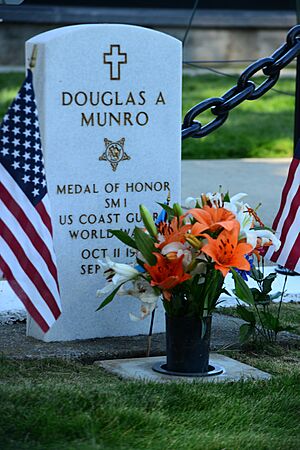Douglas Albert Munro facts for kids
Quick facts for kids
Douglas Albert Munro
|
|
|---|---|
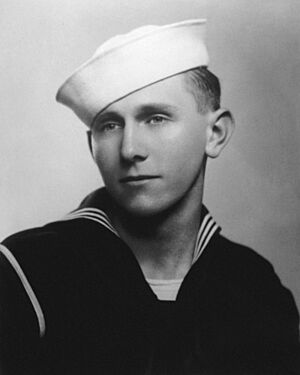 |
|
| Nickname(s) | "The Gold Dust Twins" (with Ray Evans) |
| Born | October 11, 1919 Vancouver, British Columbia, Canada |
| Died | September 27, 1942 (aged 22) Matanikau River, Guadalcanal, Solomon Islands |
| Buried |
Laurel Hill Memorial Park,
Cle Elum, Washington, United States |
| Allegiance | United States |
| Service/ |
United States Coast Guard |
| Years of service | 1939–1942 |
| Rank | Signalman First Class |
| Service number | 217–739 |
| Battles/wars | World War II
|
| Awards | Medal of Honor Purple Heart |
| Memorials | Douglas Munro Memorial (Honiara, Solomon Islands) Douglas Munro Memorial (Crystal River, Florida) Douglas Munro Burial Site (Cle Elum, Washington) Douglas Munro statue (Cape May, New Jersey) Douglas Munro bust (Washington, D.C.) |
| Relations | Edith Munro (mother) Francis Fairey (uncle) |
Douglas Albert Munro (born October 11, 1919 – died September 27, 1942) was a brave United States Coast Guard hero. He received the Medal of Honor after he died for his amazing courage during World War II. He is the only Coast Guard member ever to get this special award.
Munro was born in Canada. His family moved to the United States when he was a child. He grew up in South Cle Elum, Washington. He went to college before joining the military, just before the U.S. entered World War II. Munro and his friend Raymond Evans were known as the "Gold Dust Twins" because they were always together.
During the Guadalcanal Campaign, Munro worked at a special base called Naval Operating Base Cactus. This base helped organize small boat missions. In September 1942, during the Second Battle of the Matanikau, he led a rescue mission. He helped save a group of Marines who were surrounded by Japanese forces. Munro died at age 22 from a gunshot wound. He was using his Higgins boat to protect another boat full of Marines from Japanese gunfire.
Many ships, buildings, and monuments have been named after Munro. A street in his hometown is also named for him. His death is remembered every year in Cle Elum and at Coast Guard Training Center Cape May. His grave is a historical site in Washington state.
Contents
Douglas Munro's Early Life and School
Douglas Albert Munro was born on October 11, 1919, in Vancouver, British Columbia, Canada. In 1922, his family moved to South Cle Elum, Washington. His father worked there as an electrician.
As a young person, Munro was very musical. He played drums, trumpet, and harmonica. He was part of a drum and bugle corps and later became its leader. Munro was also a Boy Scout. He went to Cle Elum High School and was on the wrestling team.
After graduating high school in 1937, Munro went to Central Washington College of Education. He chose this college because it was close to home. This allowed him to keep playing in his drum and bugle corps. He was also a "yell king" (a male cheerleader) at college.
In 1939, with war becoming a bigger threat, Munro decided to leave college. He chose to join the military. He told his sister he picked the Coast Guard because its main job was saving lives. Munro was a bit small, so he ate a lot the week before joining to meet the Coast Guard's weight rules. He spent his last night in Cle Elum with his close friend, Mike Cooley.
Munro went to Seattle to join up. There, he met and became friends with Ray Evans. Munro and Evans stayed together for the rest of Munro's Coast Guard career. Their shipmates called them "the Gold Dust Twins."
Munro's Coast Guard Career
Munro and Evans trained at Coast Guard Air Station Port Angeles. Then, they were sent to the ship USCGC Spencer. They served on this ship until 1941. Munro always got high marks in his evaluations. According to Evans, Munro wanted to make the Coast Guard his lifelong career.
Serving in the Guadalcanal Campaign
In mid-1941, tensions with Japan grew. The U.S. government began getting ready for war. The Coast Guard moved from the Treasury Department to the Navy Department. Munro and Evans volunteered to join the ship USS Hunter Liggett. This ship was being prepared for war.
By mid-1942, the Hunter Liggett was helping with the Guadalcanal Campaign. Navy sailors started training to handle small boats with help from the Coast Guard. There weren't enough boat drivers, so Munro and Evans volunteered to learn. Before the first landings at the Battle of Tulagi and Gavutu–Tanambogo, Munro worked for Rear Admiral Richmond Kelly Turner. He was trained to drive boats and send signals. He was ordered to take troops to shore and then join a Marine unit to help with communication.
After the Allies won at Tulagi, Munro and Evans worked at Naval Operating Base (NOB) Cactus. This base was on the northern coast of Guadalcanal. NOB Cactus was a communication center between land forces and ships. Munro volunteered to work there because he liked Commander Dwight Dexter, who led the base.
On September 20, 1942, Munro volunteered for a rescue mission. He went to find the crew of a Navy plane that had crashed near Savo Island. During the mission, Munro's boat came under heavy fire from Japanese positions on shore. But he managed to get the boat back to base. The plane's crew was later found and rescued by another aircraft.
On September 27, a Marine officer named Lt. Colonel Chesty Puller ordered Marines to attack Japanese positions near the Matanikau River. Munro was put in charge of two large landing crafts and eight smaller Higgins boats. Their job was to take the Marines to their landing spots. After a ship fired shells at the beach to clear it, the Marines landed and moved inland. Munro took his boats back to Lunga Point, carrying injured sailors and Marines.
The U.S. Marines then faced a strong Japanese counterattack and were surrounded on a hill. The ship Monssen fired its guns to clear a path to the beach. Puller ordered the Marines to fight their way to the shore.
At Lunga Point, the landing crafts were told to go back and pick up the trapped Marines. Commander Dexter asked Munro and Evans if they would lead this dangerous mission. Munro quickly said, "Hell yes!" As Munro's boats got close to the beach, they came under heavy fire from the Japanese. Munro used a machine gun on his boat to fire back. This helped protect the other boats as they picked up the Marines.
With Japanese troops moving towards the beach, Munro drove his boat even closer to shore. He used his boat as a shield to protect the Marines. While the rescue was almost done, one of the large landing crafts got stuck on a sandbar. Munro told another boat to help free it. He kept his own boat between the Marines and the Japanese fire. Munro was shot in the back of his head and passed out.
The stuck boat was freed, and all the boats began to leave. Once they were safe from Japanese fire, Munro briefly woke up. According to Evans, Munro's last words were, "Did they get off?" Evans said that when he nodded yes, Munro smiled and then was gone.
Burial and Special Award
Munro was buried on September 28, 1942, the day after he died, on Guadalcanal. His grave was marked with a wooden cross made by his friend Evans.
News of Munro's brave actions first appeared in The Seattle Times on October 15, 1942. However, the first reports did not say he had been killed. Four days later, Coast Guard officers told Munro's parents about his death. A memorial service was held for him on November 1.
Colonel Puller, the Marine officer Munro helped save, nominated him for the Medal of Honor. This is the highest U.S. military award. President Franklin Roosevelt approved the award around May 1, 1943. Munro's parents received the medal from President Roosevelt at the White House on May 24.
The award citation said Munro showed "extraordinary heroism" and "conspicuous gallantry." It described how he bravely led his boats to rescue nearly 500 Marines trapped by the enemy. He put his boat and its small guns between the Marines and the Japanese to protect them. He was killed while the rescue was almost finished, but his crew kept going until everyone was safe. His leadership and courage saved many lives. He bravely gave his life for his country.
Today, Munro is the only member of the U.S. Coast Guard to have received the Medal of Honor.
Munro's body was brought back from Guadalcanal in 1947. He was reburied at Laurel Hill Memorial Park in Cle Elum in 1948. His family chose not to have a full military burial at Arlington National Cemetery. In 1954, two old naval guns were placed next to his tombstone. Munro's parents were later buried next to him. His grave site is now a historical site in Washington state.
Munro's Legacy
Monuments and Memorials
Three United States ships have been named after Munro: the destroyer escort USS Douglas A. Munro (DE-422), and the cutters USCGC Douglas Munro (WHEC-724) and USCGC Munro (WMSL-755). As of 2018, USCGC Munro (WMSL-755) is still active in the Coast Guard.
Three Coast Guard buildings are named in honor of Munro: Munro Hall at the United States Coast Guard Academy, Munro Hall at United States Coast Guard Training Center Cape May, and the Douglas A. Munro Coast Guard Headquarters Building in Washington, D.C. The headquarters building was named by an act of Congress and opened in 2013.
Many monuments have also been built for Munro. These include a bronze statue at Coast Guard Training Center Cape May, a large bust at the Douglas A. Munro Coast Guard Headquarters, and a black marble pillar at the Coast Guard Academy. There is also a memorial in the Solomon Islands and one in Crystal River, Florida. In 2006, Munro was added to the Wall of Heroes at the National Museum of the Marine Corps. He is the only non-Marine honored there.
In Cle Elum, Washington, a street is named Douglas Munro Boulevard.
Special Observances
At Coast Guard Training Center Cape May, new recruits gather at Munro's statue every year on the anniversary of his death. They fire a three-volley salute to honor him.
July 24, 2009, was named Douglas Munro Memorial Day in Washington State by Governor Christine Gregoire.
-
Coast Guard officers, attended by a guard of honor of the Washington State Patrol, lay a wreath at the Medal of Honor memorial in Olympia, Washington on Douglas Munro Memorial Day in 2009.
Cooley Flagpole at Munro's Grave
For many years, Munro's childhood friend, Mike Cooley, raised and lowered the United States flag at Munro's grave every day. He walked three miles from his home to the cemetery. According to Cooley's daughter, he never missed a day for over 30 years, even when he was sick. When Cooley died in 1999, a special lighted flagpole was put up. This allows the U.S. flag to fly continuously at Munro's grave without needing to be lowered at night. Cooley's ashes were buried at the Douglas Munro Burial Site with the Munro family.
Since the new flagpole was put in, a military ceremony is held at the grave site every year on the anniversary of Munro's death. In 2017, the 75th anniversary ceremony was attended by the head of the Coast Guard, Admiral Paul Zukunft.
Other Tributes
In 1989, the Coast Guard ordered a painting called Douglas A. Munro Covers the Withdrawal of the 7th Marines at Guadalcanal by Bernard D'Andrea.
The Veterans of Foreign Wars post in Cle Elum is named the Douglas Munro-Robert H. Brooks VFW Post 1373. The Douglas A. Munro Award is given every year to an enlisted Coast Guardsman who shows great leadership. The "Douglas Munro March," a song composed by Lewis J. Buckley, was first played by the United States Coast Guard Band in 1982. In 2014, the Coast Guard Foundation started the Douglas Munro Scholarship Fund. This fund gives college scholarships to children of U.S. Coast Guard members.
Several members of Munro's family have been named Douglas to honor him.
Douglas Munro's Ranks
Awards and Medals
Besides the Medal of Honor, Munro also received other awards. These include the Purple Heart, the Coast Guard Good Conduct Medal, the American Defense Service Medal, the American Campaign Medal, the Asiatic-Pacific Campaign Medal (with one battle star), and the World War II Victory Medal.
| Medal of Honor | |||||
| Purple Heart Medal | Coast Guard Good Conduct Medal | American Defense Service Medal | |||
| American Campaign Medal | Asiatic-Pacific Campaign Medal with one battle star | World War II Victory Medal | |||
See also


